One of the original three lenses launched alongside the mirrorless Nikon Z cameras, the Nikkor Z 35mm f/1.8 S is a moderately fast, mildly wide-angle prime lens designed specifically for the Nikon Z system.
The 35mm focal length and 63º angle of view makes it an ideal choice for street photography and photojournalism, as well as for general-use photography. Combine that with a wide f/1.8 maximum aperture for better low-light photography and creative depth-of-field effects, and the Z 35mm f/1.8 S is a highly desirable optic for many Nikon Z shooters.
The optical arrangement utilizes 11 elements in 9 groups, including 2 ED elements, 3 aspherical elements, and elements with Nikon’s Nano Crystal Coating to reduce flare and ghosting, all housed in a sealed barrel that protects against dust and water droplets. Controls on the barrel are limited to an AF/MF switch and what Nikon calls a control ring. The control ring is essentially a manual focus ring for precision focusing in MF mode, but you can also assign exposure-compensation settings to the control ring when in AF mode, which adds some functionality over traditional Nikon F-mount 35mm lenses.
There’s no lens-based image stabilization (VR), due to the fact Nikon Z cameras feature 5-axis in-body image stabilization (IBIS), but the Nikkor Z 35mm f/1.8 S does feature a near-silent autofocus stepping motor to reduce, if not eliminate, focusing noise captured by the on-board mic during video recording. Measuring 86x73mm (LxD) and weighing 370g, it’s a fairly large 35mm prime lens, especially compared to the older Nikkor D-mount version, but it remains well balanced and practical to use on the smaller Nikon Z cameras.
Key specifications:
- Full-frame format
- Available in Z-mount only
- Aperture range f/1.8–f/16
- 62mm filter thread
- Minimum focus distance: 25cm
- Weight: 370 grams
Overall lens image quality
Tested on the high-resolution 45.7MP Nikon Z 7 mirrorless camera, the Nikkor Z 35mm F1.8 S ranks as the highest-scoring Nikon 35mm lens we’ve tested, achieving an overall score of 38 points and an impressive sharpness sub-score of 30 PMpix at f/4.
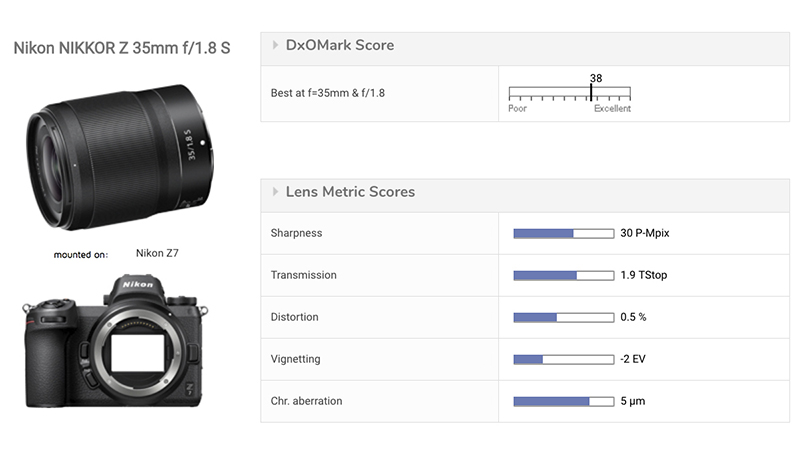 Sharpness is good at all aperture settings, with particularly strong results between f/4 to f/8, where images are sharp edge-to-edge. At the wider f/1.8- and f/2.8-aperture settings, resolution is also very good in the center of the frame; and although things get a little softer in the outer field, it remains very acceptable overall. The effects of diffraction start to impact sharpness a little at f/11, but acutance remains good at around 70%, so it’s only really at the minimum f/16 aperture that diffraction has a noticeable impact.
Sharpness is good at all aperture settings, with particularly strong results between f/4 to f/8, where images are sharp edge-to-edge. At the wider f/1.8- and f/2.8-aperture settings, resolution is also very good in the center of the frame; and although things get a little softer in the outer field, it remains very acceptable overall. The effects of diffraction start to impact sharpness a little at f/11, but acutance remains good at around 70%, so it’s only really at the minimum f/16 aperture that diffraction has a noticeable impact.
Correction of lateral chromatic aberration is another strength for the Nikon Z 35mm f/1.8 S, with no evident fringing at any aperture setting. Fairly strong vignetting is noticeable at the wider f/1.8 and f/2.8 aperture settings, however, and although it’s noticeably reduced between f/4 to f/16, some corner shading is visible at all apertures on this lens. We measured a little barrel distortion of 0.5% in our tests, but this isn’t unusual for a “mild” wide-angle lens, and it won’t have too much impact on the straightness of lines in your images. Transmission is also good at f/1.9 TStop, ensuring plenty of light for the EVF and autofocus system; further, you can expect generally accurate auto-exposure with this lens.
Image quality compared
Despite being the highest-scoring Nikon 35mm prime lens we’ve tested so far, the Nikkor Z 35mm f/1.8 S doesn’t quite live up to the high bar set by some of the competition.
Click here to open our interactive DxOMark lens comparison tool.
Tested on the 36Mp Nikon D800E, the similarly-priced Sigma 35mm f/1.4 A and Tamron SP 35mm f/1.8 Di both achieved the same (or very nearly the same) sharpness score on a lower-resolution sensor. Add to that slightly less barrel distortion and vignetting, as well as improved transmission on the Sigma and less fringing on the Tamron, and the third-party options top the table for 35mm primes for Nikon shooters.
The analysis results are broadly the same when comparing the Nikkor Z 35mm f/1.8 S to 35mm primes on the high-resolution Sony and Canon cameras. On the 42.4Mp Sony A7R II, the Carl Zeiss Distagon T* FE 35mm f/1.4 is comfortably ahead for sharpness; and the significantly more compact Sony FE Carl Zeiss Sonnar T* 35mm f/2.8 ZA also just edges out the Nikkor lens for sharpness and vignetting.
Canon shooters can rest assured that the EF 35mm f/1.4L II is also noticeably sharper than the Nikkor Z lens when tested on the 50.6Mp Canon 5DS R. The EF lens is a significantly more expensive and chunkier lens, as you’d expect with a f/1.4 maximum aperture; and although vignetting is rather strong, it controls distortion extremely well, and transmission and chromatic aberration are fractionally better than the Nikkor lens, too. The cheaper and more diminutive EF 35mm f/2 is also a good option for Canon shooters who don’t require a truly “fast”-aperture 35mm prime, and it delivers slightly better sharpness overall, and achieves similar sub-scores as the Nikkor Z 35mm f/1.8 S in the other categories as well.
In-depth comparisons
For a more detailed examination of optical performance, we’ll compare the new Nikkor Z lens with two f/1.8 35mm F-mount primes: the slightly cheaper AF-S Nikkor 35mm f/1.8G, and the slightly more expensive Tamron SP 35mm f/1.8 Di. As they’re made for Nikon DSLRs, we’ve mounted them on the highest-resolution Nikon DSLR we’ve tested, the D800E. (Check back to see the results on our interactive comparison tool after we’ve added the data from the latest 45.7MP Nikon D850).
Sharpness
At the maximum f/1.8 aperture, both the Tamron and Nikon AF-S lenses offer improved resolution across the majority of the frame, up to a field position of 80%. The Nikon Z lens improves fractionally over the AF-S 35mm f/1.8G in the far outer field, but again, the Tamron option is sharper, as well as more homogeneous into the corners. Nikon has managed to control astigmatism (aberrations in the optical system) really well on the new Z lenses, however, and this is indicated by the dashed lines for the Tamron and Nikkor AF-S lens on the chart below.
At peak sharpness using an aperture of f/4, the new Nikon Z 35mm f/1.8 S slightly outperforms the competition, which helped it achieve the highest sharpness score of the three lenses overall. All three are excellent in the center of the frame, achieving actutance scores of just over 80%, but where the Tamron and Nikon AF-S lens dip slightly in the outer field, the Nikkor Z lens manages to achieve fractionally more uniform resolution out to the corners.
Chromatic aberration
The graph below shows the width in microns for the two measured values of lateral chromatic aberration for each lens at f/1.8, from the image center at 0% to the corners of the frame at 100%. (There are two values because lateral color is revealed in the focus plane on either side of high-contrast edges, usually as cyan and magenta fringing. If a lens were perfectly corrected, both values would be at 0µ on the grey horizontal line.)
You can see in the chart below that both the Nikkor Z lens and the Tamron alternative control chromatic aberration extremely well, with both values for these two lenses deviating not very far from the 0µm position, even in the far outer field (field position 100%). The AF-S lens isn’t quite as good, with the deviation of the royal blue and orange lines indicating some visible chromatic aberration in the outer field.
Don’t forget that this type of fringing is usually easy to clean up either in-camera or post-capture, and rarely lowers image quality after removal.
Geometric distortion
It isn’t uncommon for wide-angle lenses to show some geometric distortion, and lines aren’t often perfectly straight even with “mild” wide-angle 35mm lenses. One of the key strengths of the Tamron 35mm is that it will be difficult to perceive any effect of its 0.2% barrel distortion on straight lines. At 0.4% for the AF-S 35mm and 0.5% for the Nikkor Z 35mm, that barrel effect will be slightly noticeable on linear elements, however, and especially on lines close to the edges of the frame. Even so, it’s all pretty well-controlled, and with some post-production correction, you’ll be able to reduce the effect without losing too much of the image in the consequent cropping to remove dead space.
Vignetting (corner shading)
Illumination fall-off towards the corners is shown in the graph below for each of the three lenses at its widest aperture, where it would be at its most noticeable. As with lateral chromatic fringing, vignetting can be easily removed in-camera or after capture via software, but if it’s particularly pronounced, it can reveal noise after removal, so it’s always better for the shading to be lower to begin with.
Despite the wider mount, the Nikkor Z lens displays the most noticeable vignetting of the three options. With –1.4EV corner shading compared to –1.7EV and –2EV for the AF-S 35mm and Nikkor Z 35mm lenses, respectively, the Tamron requires less correction to achieve consistent illumination across the frame when shooting at the widest aperture setting. As you close down the apertures, the Tamron and Nikon AF-S lenses improve quicker compared to the Nikkor Z lens, too, which displays vignetting of around –0.7EV at all apertures between f/4 and f/16. In fact, the Nikon AF-S measured the best of the three from f/4 onwards, with less than –0.5EV corner shading evident, although the Tamron 35mm isn’t far behind.
Conclusion: Top-performing Nikon 35mm lens
The new wider Z-mount with its shorter register means there’s a lot more flexibility for optical engineers when designing lenses. The mount should especially benefit wide-angle lenses, and indeed, the Nikon Z 35mm f/1.8 S is the highest-scoring Nikon 35mm lens we’ve tested to date. Its key strength is sharpness, with good performance at the maximum aperture and exceptionally uniform resolution at the mid-apertures. This said, it doesn’t quite match such third-party options as the Sigma 35mm f/1.4 A and the Tamron SP 35mm f/1.8 Di, which achieve better sharpness when tested on the lower-resolution 36.3Mp Nikon D800E, compared to the Nikkor Z lens on the 45.7Mp Nikon Z 7. Overall, however, Nikon Z-system shooters who are looking for a 35mm prime can rest assured that the native Nikon Z 35mm f/1.8 S lens is an optically excellent choice.
In this review, we have compared the Nikkor Z 35mm F1.8 S to its F-mount predecessor, and from a quality perspective, to a third-party rival from another brand. Remember that the lenses are intended to be used on different camera systems and mounts, so the comparisons may not be strictly applicable.
As usual, you can create your own comparisons and in-depth analyses using our interactive image lens comparison tool.


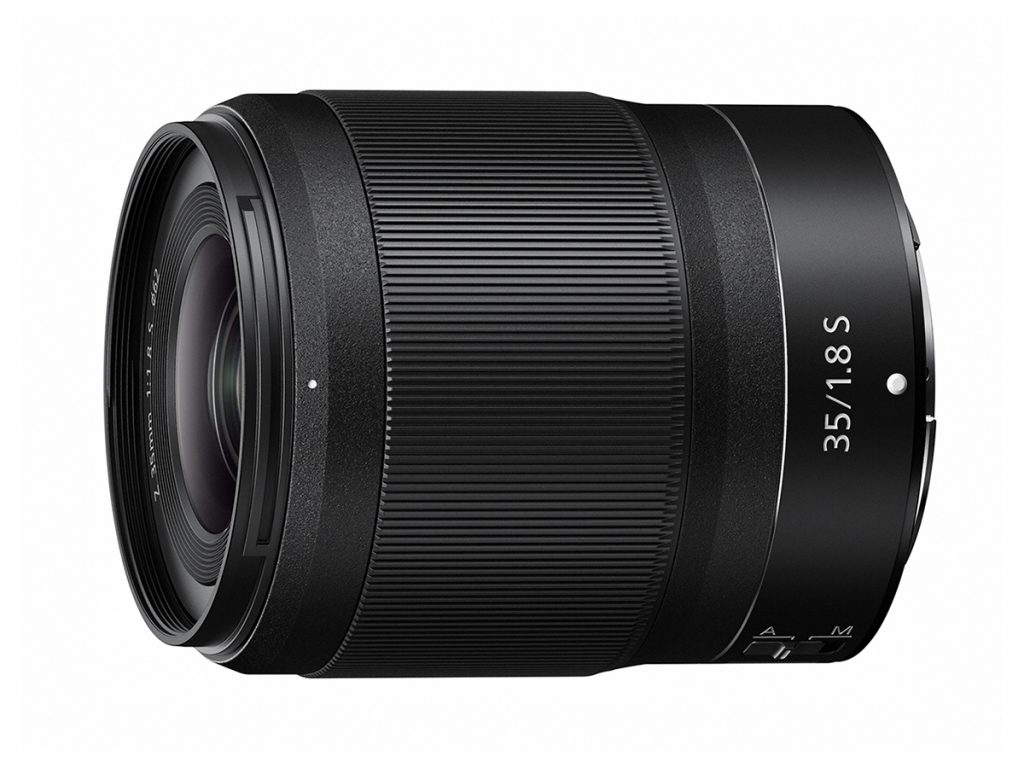


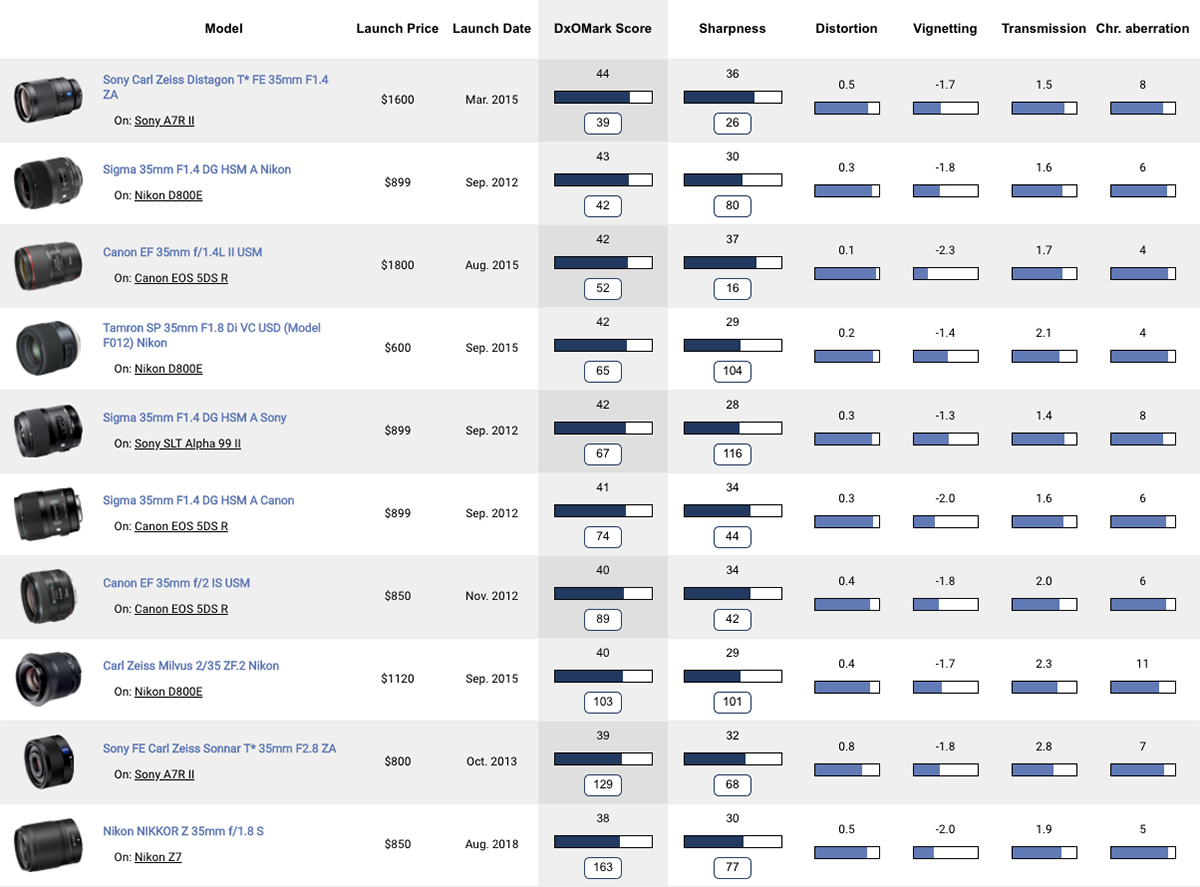
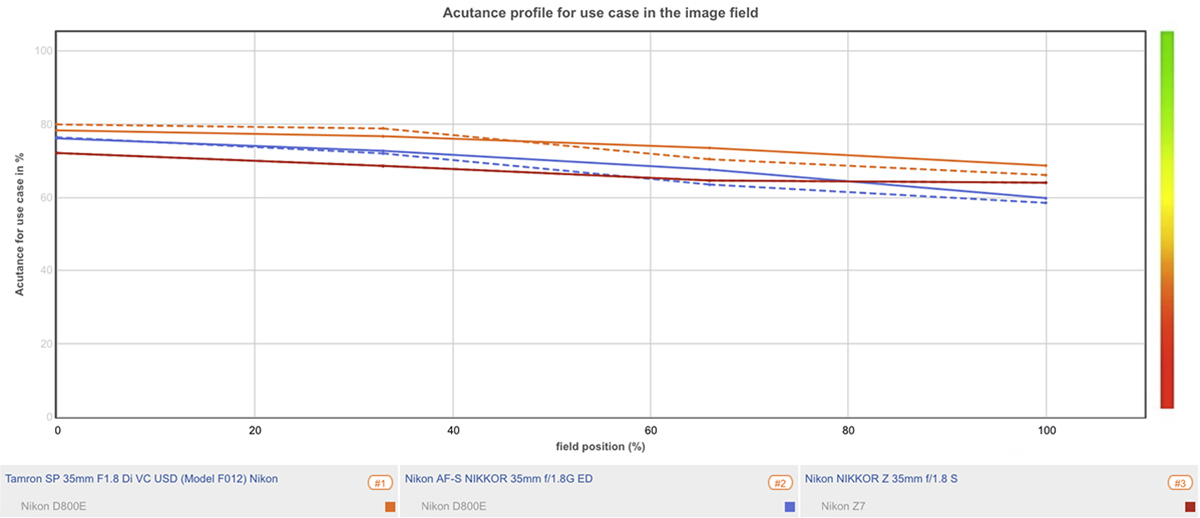
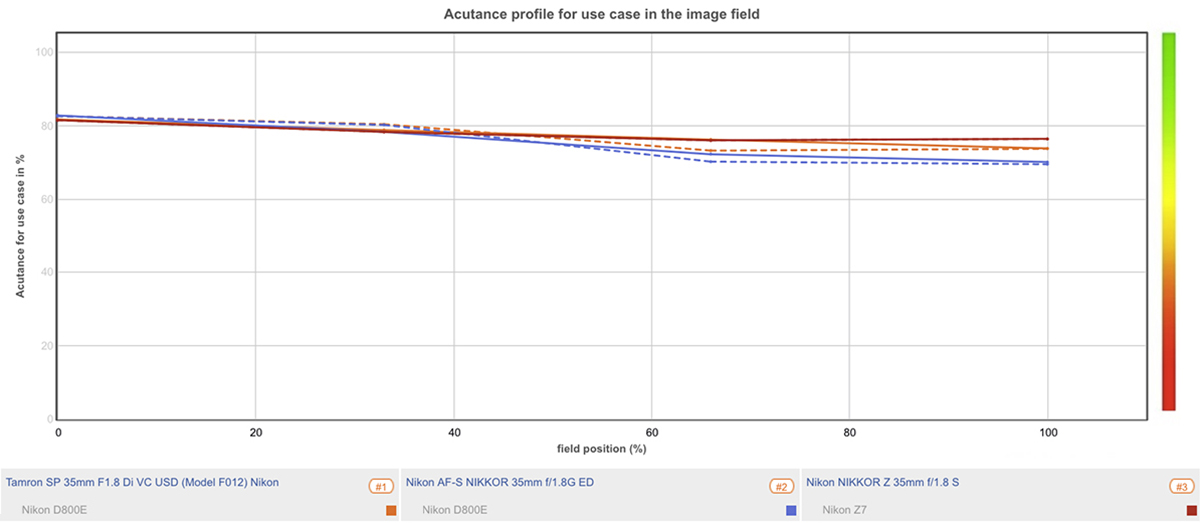
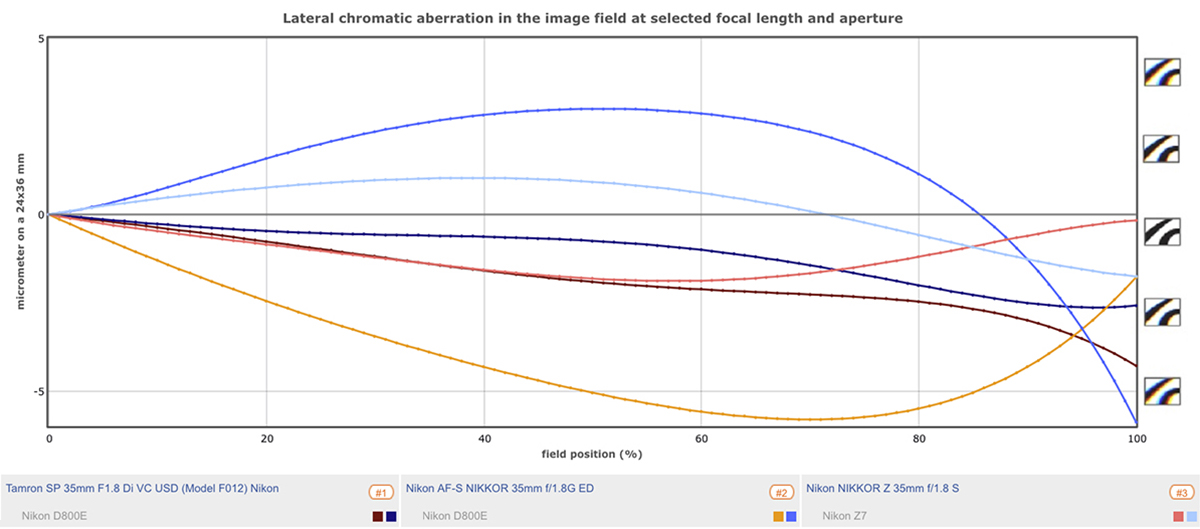
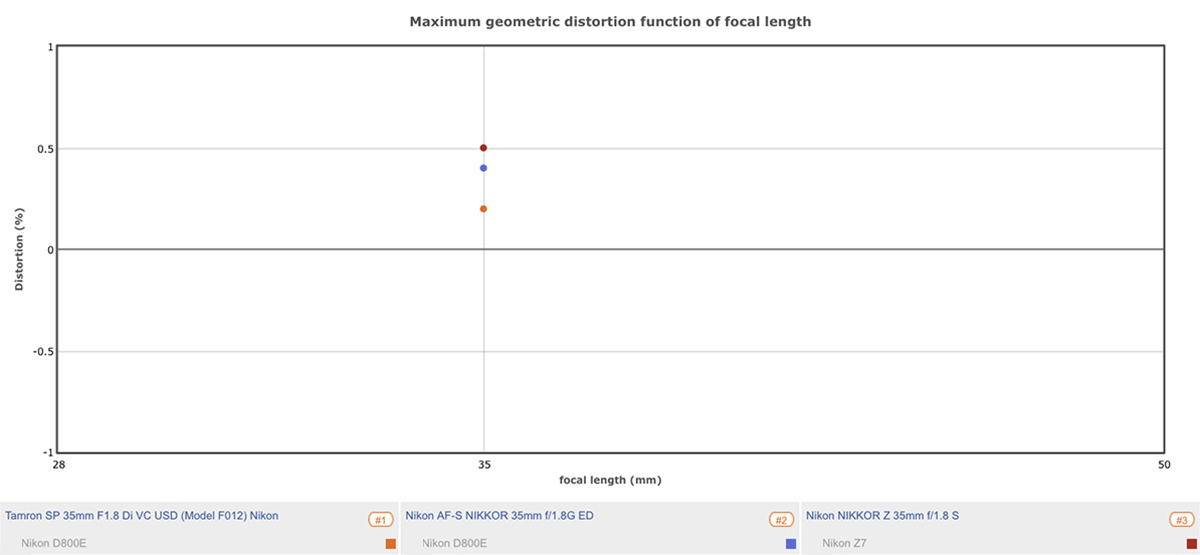
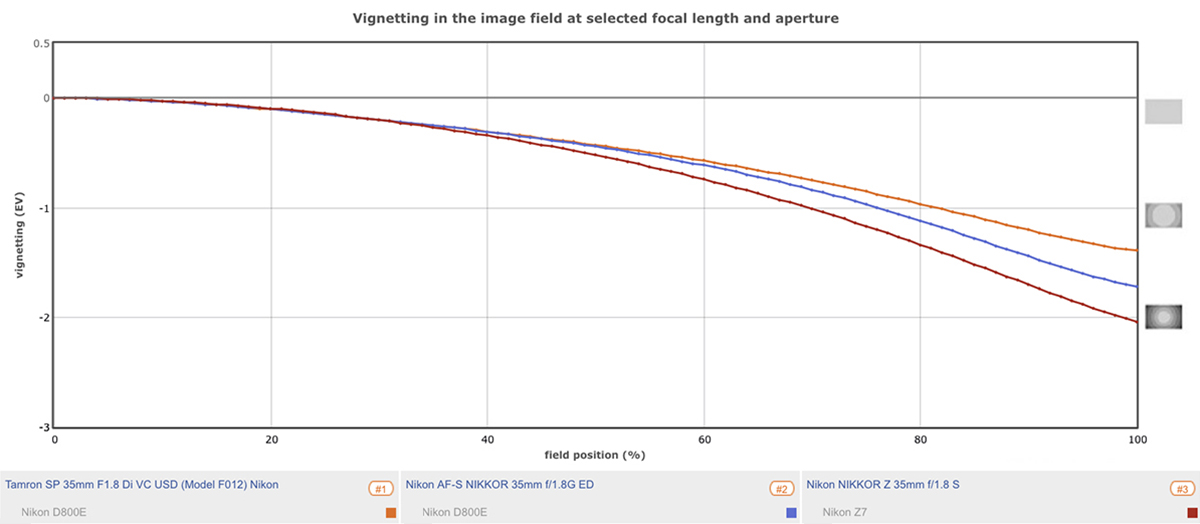

DXOMARK encourages its readers to share comments on the articles. To read or post comments, Disqus cookies are required. Change your Cookies Preferences and read more about our Comment Policy.